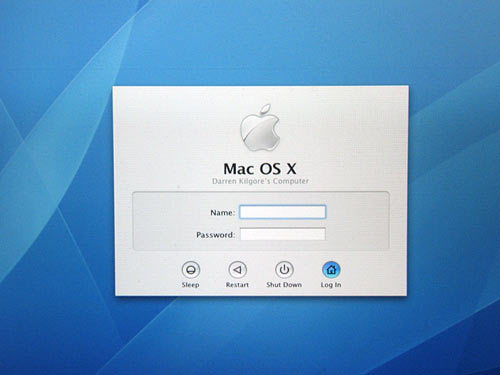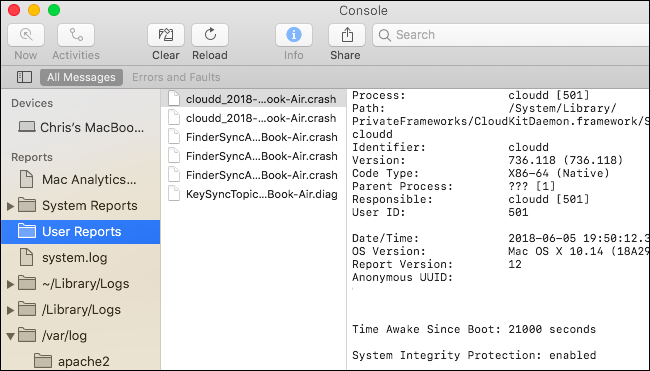고정 헤더 영역
상세 컨텐츠
본문

Tuesday, January 12th, 2016 Author: Before the holidays, I was running into an odd problem with my new iMac, and when I mean “odd”, I mean that it was acting as if someone was trying to access my Mac from somewhere else. Now, I’m one of those people who always enables the OS X firewall, so the chances of a hacker attack actually occurring were probably pretty slim. But after a few days of perplexing symptoms I decided I’d better see whether someone or something was actually attempting an attack.
Multiple log files can be loaded at the same time and shown in a single view with messages being sorted by time. Log formats are automatically detected and new log formats can be defined using a JSON file with the appropriate regular expressions. Compressed (gzip and bz2) files are automatically decompressed.
- OS X: How to View Log Files Posted November 2, 2008 by David Kirk in Apple Mac If your OS X system is acting flakey, checking out the log files is a great place to start your exploration of what is going wrong.
- Does anyone know a way to monitor and audit file access events on a mac? I'm thinking of building a splunk server to record file access event logs from a mac but have no idea how to configure the mac to output such events.
Log View For Mac Windows 10
To do this, I watched the OS X firewall log to see what was happening each time the symptoms occurred. Here’s how to do the same if you’re feeling as paranoid as I was OS X Firewall To start with, what’s a firewall? Simply stated, it’s an application that closes all or specific internet protocol (IP) ports on your internet connection, allowing only incoming connections that are necessary to the regular operation of your Mac.
For example, things like email, information coming into a web browser via the http protocol, and video streaming connections all have specific ports assigned to them, and your Mac — even with the firewall turned on — lets those services work normally. To enable the OS X firewall, go to System Preferences Security & Privacy and then click on the Firewall tab. You’ll know immediately if the firewall is turned on or not; if it’s on, there’s a green light and a text notification that the firewall is on (see image below). You can choose to block all incoming connections, which provides the highest level of security from intruders, just by checking the top checkbox. You can add specific applications to the “open” connection list by clicking the plus ” + ” sign below the list of allowed connections, then selecting the apps from your Applications folder. The second check box allows software that is signed by a valid certificate authority to provide services to your computer (this should be checked), and the last check box makes it impossible for malicious users to even know that your computer exists by turning off responses to test applications that make use of ICMP (Internet Control Message Protocol).

At this point, let’s assume that your OS X firewall has been enabled since you first turned on the computer and you’re still seeing some odd things happening. Your next step is to look at the OS X firewall log, and there are two different ways to do that. View the Firewall Log in Console The Console utility in OS X is used to view log files that are created by most system services for the purposes of troubleshooting problems. It can be found in the Utilities folder that’s located in the Applications folder, or easily accessed from the Finder by selecting Go Utilities. Once you’ve launched Console, go to the left sidebar of the app, look under Files, and then find appfirewall.log under /var/log. Clicking on that log file displays a list of all actions that have occurred. The following image shows a fairly clean log file, with just the iTunes app “listening” and “connecting” through the firewall: What you want to look for are repeated blocked attempts from or to specific apps or services on your Mac.
In addition, if you see connections that are taking place with an app or service you’re not familiar with or do not have installed, you might have cause for concern. To see whether that service or app is indeed causing the issue that you’re experiencing with your Mac, see if you can find it in the list of allowed connections in the Firewall settings and then click on the toggle on the far right of the list (see image below). Select “Block incoming connections” to see if the problem is resolved. You may need to do this for various apps or services listed in the firewall connections list. View the Firewall Log in Real Time in Terminal If things are really getting weird, you can always choose to watch the firewall log in real time in the Terminal app. It’s also found in Applications Utilities. Once launched, type in the following command: tail -f /var/log/appfirewall.log That command lists the entire firewall log up to this point in time, then lists any new entries as they are added (see image below).
This is very useful in identifying apps that are constantly attempting to connect and disconnect. If you’re not familiar with Terminal, note that you will need to type Control-C to quit the live logging and then type exit to log out of the terminal session. Fortunately for me, all of my troubleshooting was for naught, as I found out that it was a setup issue with my Wi-Fi router that was causing the odd problems I was seeing. But it’s always worth knowing a few tricks that may help you in the future. Be sure to check out the Rocket Yard’s for more tips and tricks for OS X and iOS. Cerniuk – I suspect that putting this into the preference panel would not only confuse most people but would not mean anything either and to look into the terminal is not only easy but prefered for most techs who understand Unix/Linux – the distant past doing anything via the command line was the only way to do anything – the Gui allows most people easy access to what they will need in a day to day basis most people don’t need terminal day to day nor would they understand it. As you know using the command line incorrectly can muck the system up, I don’t need to tell you this In my experience Intego’s netbarrier pretty much does nothing and does not stop anything – using linux a professional tech I know broke through netbarrier really easy – netbarrier not only did not stop the intrusion but also did not see the intrusions happing in real time We were contracted with a business who used only Mac’s, with the company you referenced, full suite (firewalls on) and their network was seriously compromised and all their systems had snoops stealing info.
Using both terminal and a couple other security utilities we could see how compromised the systems were. Netbarrier did nothing to stop this. We ended up having to do a bare metal wipe and re-install with a different security suite course, what did not help was the user’s passwords were terribly easy to break too – that old problem. Recent Posts.
Macs last a long time. Don't plunk down your hard earned money on a new Mac when an upgraded Mac can run faster than a new Mac. We have the best upgrades and support for Macs: The easiest and most cost effective way to get the most from your Mac. Open and create more at one time with less slowdowns. SSDs are up the 91 times faster than a hard drive. Unleash the true potential of you Mac by upgrading to an OWC SSD.
OWC Install Videos guide you step-by-step so you can experience the blazing performance difference an OWC SSD offers. Easily expand your storage with durable external drives from OWC. From bus-powered portables to massive capacity desktop models, our external drives are time-tested and industry trusted to provide you great reliable storage whatever your needs may be. Who says the optical drive is dead? Optical storage offers a great way to archive data long term, and Blu-ray media offers a tremendous amount of storage in a single disc. Watch Blu-ray movies to experience near studio master image quality. Our award-winning U.S.


Based customer service is at the ready to help you with any upgrade questions you may have. We're available online and on the phone 24/7. Say hello today and find out what your Mac can do.
Last Updated: 21 Sep 2015 Since MAC addresses are how equipment, such as hosts or computers on the network are uniquely identified, traffic going to and from a specific computer can be traced using the MAC address recorded in the log files. If you want to be anonymous on the local network, you may want to change your MAC address before you connect to a network, so that the network would log your activities using the arbitrary MAC address you self-assigned.
Check out the tools section on the website on how to do this.





